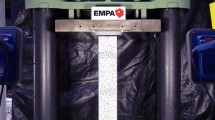Abstract
The study concerns the question of how the shape stability features of laminated columns of Norway spruce can be improved in terms of twist through optimal orientation of the individual laminates. Both experimental testing and numerical simulations were employed for evaluating twist stability. In all the columns studied, deformations were measured experimentally at different moisture content levels. A number of columns were also selected for numerical analysis in order to obtain a more thorough understanding of the twist behavior involved, their geometries and material properties of interest being determined. The experimental results showed the twist stability of the columns to be highly dependant upon the internal orientation of the individual laminates. It was also found that high quality columns in terms of shape stability could be manufactured, even when the center-core material has a strong twist tendency. The numerical simulations performed were in close agreement with the experimental results.
Zusammenfassung
Diese Studie befasst sich mit der Frage, wie die Verdrehung von Kreuzholzbalken aus Fichte durch optimale Anordnung der zu verklebenden Teile reduziert und dadurch die Formstabilität der Balken verbessert werden kann. Die Formstabilität der Balken wurde sowohl experimentell als auch mit Simulationsrechnungen untersucht. Bei allen untersuchten Balken wurden Verformungen bei unterschiedlichen Holzfeuchten experimentell gemessen. Um das Verdrehungsverhalten besser zu verstehen, wurde dieses bei einigen Balken rechnerisch untersucht. Dazu wurde deren Aufbau und die relevanten Materialeigenschaften bestimmt.
Die Versuchsergebnisse belegten die grosse Abhängigkeit der Formstabilität von der Anordnung der Einzelteile. Ausserdem zeigte sich, dass hochwertige formstabile Balken auch aus marknahem Holz mit starkem Drehwuchs hergestellt werden können. Die rechnerische Simulation stimmte mit den Versuchsergebnissen sehr gut überein.
Similar content being viewed by others
References
Cooper G, Maun K (2003) Reducing distortion by green gluing and reengineering. Seminar: Advances in wood drying. COST Action E15, STRAIGHT, 20 November, Limerick University, Limerick
Dahlblom O, Petersson H, Ormarsson S (2000) Stiffness, strength and shape stability grading analysis of sawn timber based on experimentally found growth characteristics. In: Proceedings of the World conference on timber engineering, 31 July–3 August Whistler, Canada
Dahlblom O, Petersson H, Ormarsson S (2001) Full 3-D FEM-simulations of drying distortions in Spruce boards based on experimental studies. In: Proceedings of the 7th International IUFRO Wood Drying Conference, 9–13 July, Tsukuba, Japan
Eriksson J (2004) Study of moisture flow and moisture induced distortions in sawn boards and laminated timber products. Lic. thesis, Publication 2004:2, Dept. of Structural Engineering and Mechanics, Chalmers University of Technology, Gothenburg
Eriksson J, Ormarsson S, Petersson H (2004) An experimental study of shape stability in glued boards. Holz Roh- Werkst 62:225–232
Forsberg D (1999) Warp, in particular twist of sawn wood of Norway spruce (Picea abies). PhD thesis, Dept of Forest Management and Products, Silvestria 119, Uppsala
Johansson G, Kliger IR, Perstorper M (1994) Quality of structural timber-product specification system required by end-users. Holz Roh- Werkst 52:42–48
Johansson M (2002) Moisture-induced distortion in Norway spruce timber: experiments and models. PhD thesis, Dept of Structural Engineering, Chalmers University of Technology, Gothenburg
Ormarsson S (1999) Numerical analysis of moisture-related distortions in sawn timber. PhD thesis, Publication 99:7, Dept. of Structural Mechanics, Chalmers University of Technology, Gothenburg
Ormarsson S, Dahlblom O, Petersson H (1999) A numerical study of the shape stability of sawn timber subjected to moisture variations, Part 2: Simulation of drying board. Wood Sci Technol 33:407–423
Ormarsson S, Dahlblom O, Petersson H (2000) A numerical study of the shape stability of sawn timber subjected to moisture variations, Part 3: Influence of annual ring orientation. Wood Sci Technol 34:207–219
Ormarsson S, Petersson H, Dahlblom O (2001) Engineering tools to construct timber products with good shape stability. In: Proceeding of the 3rd European COST E15 workshop on wood drying, 11–13 June, Helsinki, Finland
Ormarsson S, Dahlblom O, Petersson H, Eriksson J (2002) Computer analysis to design laminated timber products with good shape stability. Report 02:8, Dept of Structural Mechanics, Chalmers University of Technology, Gothenburg, Sweden
Perstorper M (1994) Quality of structural timber- end-user requirements and performance control. PhD thesis, Div of Steel and Timber Structures, Chalmers University of Technology, Gothenburg
Perstorper M, Johansson M, Kliger R, Johansson G (2001) Distortion of Norway spruce timber. Part 1. Variation of relevant wood properties. Holz Roh- Werkst 59:94–103
Serrano R, Cassens D (2000) Reducing warp and checking in plantation-grown yellow-poplar 4 by 4’s revering part positions and gluing in the green condition. Forest Prod J 51:37–40
Woxblom L (1999) Warp of sawn timber of Norway spruce in relation to end-user requirements – quality, sawing pattern and economic aspects. PhD thesis, Dept of Forest Management and Products, University of Agricultural Science, Uppsala
Author information
Authors and Affiliations
Corresponding author
Rights and permissions
About this article
Cite this article
Eriksson, J., Ormarsson, S. & Petersson, H. An experimental and numerical study of shape stability in laminated timber columns. Holz Roh Werkst 63, 423–429 (2005). https://doi.org/10.1007/s00107-005-0058-8
Published:
Issue Date:
DOI: https://doi.org/10.1007/s00107-005-0058-8




